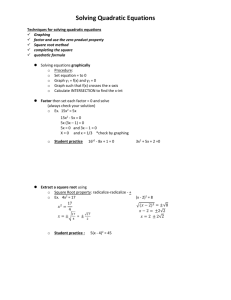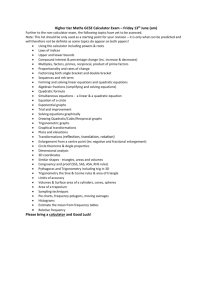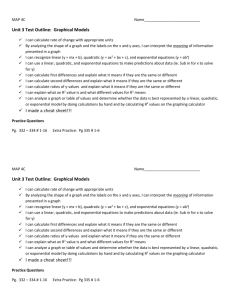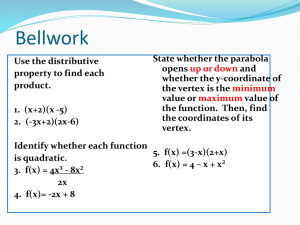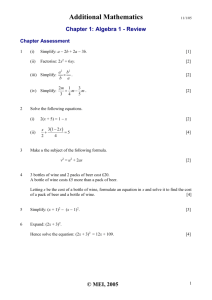Chapter 6 Irrational and Complex Numbers
advertisement
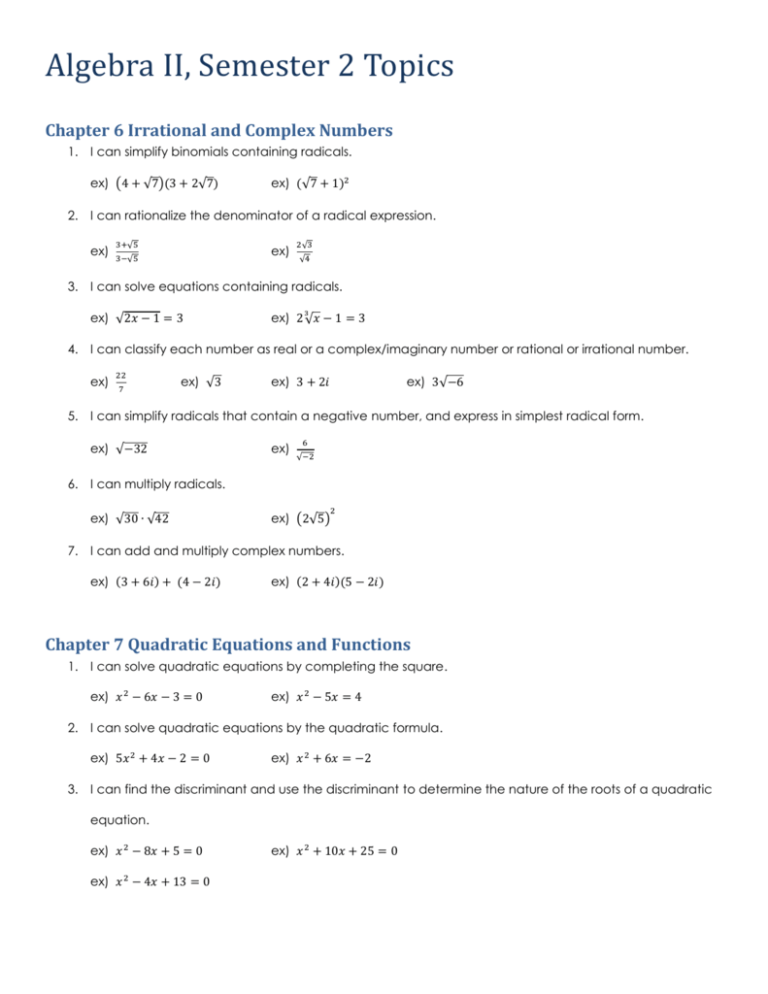
Algebra II, Semester 2 Topics Chapter 6 Irrational and Complex Numbers 1. I can simplify binomials containing radicals. ex) (4 + √7)(3 + 2√7) ex) (√7 + 1)2 2. I can rationalize the denominator of a radical expression. ex) 3+√5 ex) 3−√5 2√3 √4 3. I can solve equations containing radicals. ex) √2𝑥 − 1 = 3 ex) 2 √𝑥 − 1 = 3 3 4. I can classify each number as real or a complex/imaginary number or rational or irrational number. ex) 22 7 ex) √3 ex) 3 + 2𝑖 ex) 3√−6 5. I can simplify radicals that contain a negative number, and express in simplest radical form. ex) √−32 ex) 6 √−2 6. I can multiply radicals. ex) √30 ∙ √42 2 ex) (2√5) 7. I can add and multiply complex numbers. ex) (3 + 6𝑖) + (4 − 2𝑖) ex) (2 + 4𝑖)(5 − 2𝑖) Chapter 7 Quadratic Equations and Functions 1. I can solve quadratic equations by completing the square. ex) 𝑥 2 − 6𝑥 − 3 = 0 ex) 𝑥 2 − 5𝑥 = 4 2. I can solve quadratic equations by the quadratic formula. ex) 5𝑥 2 + 4𝑥 − 2 = 0 ex) 𝑥 2 + 6𝑥 = −2 3. I can find the discriminant and use the discriminant to determine the nature of the roots of a quadratic equation. ex) 𝑥 2 − 8𝑥 + 5 = 0 ex) 𝑥 2 − 4𝑥 + 13 = 0 ex) 𝑥 2 + 10𝑥 + 25 = 0 4. I can find the vertex of a quadratic function (min or max). ex) 𝑦 + 2 = (𝑥 + 3)2 ex) 𝑦 = −(𝑥 − 1)2 5. I can find the axis of symmetry of a quadratic function. ex) 𝑦 − 5 = 2(𝑥 − 2)2 1 ex) 𝑦 + 1 = − (𝑥 − 3)2 3 6. I can graph quadratic equations and label the axis of symmetry and the vertex. ex) 𝑦 + 4 = (𝑥 − 3)2 ex) 𝑦 − 2 = −2(𝑥 − 4)2 7. I can find all intercepts of a quadratic equation. 1 ex) 𝑦 − 7 = − (𝑥 + 6)2 2 ex) 𝑦 + 8 = −3(𝑥 − 1)2 8. I can write quadratic equations given its roots. ex) 2, 5 ex) 1 + √3, 1 − √3 Chapter 10 Exponential and Logarithmic Functions 1. I can write expressions as a single logarithm. ex) 5 log 4 𝑝 + log 4 𝑞 1 ex) 4 log 3 𝑎 − log 3 𝑏 2 2. I can expand a single logarithm into multiple logs. ex) log 2 𝑀6 𝑁 3 ex) log 3 𝑀√𝑁 3. I can change base to be the same to solve exponential equations. ex) log 4 7 ex) log 3 5 4. I can multiply each side by log when I cannot change the base to be the same to solve exponential equations. ex) 3𝑥 = 7 ex) 4𝑥 = 16 5. I can solve logarithmic expressions. ex) log 8 𝑥 = − 1 3 ex) log 2 8√2 = 𝑥 6. I can solve compound interest problems. ex) 7. I can simplify natural log expressions. (ln and e) ex) ln 𝑒 2 ex) ln 1 𝑒3 8. I can solve natural log problems. (ln and e) ex) ln 𝑥 = 3 ex) 𝑒 𝑥 = 2 ex) √𝑒 2𝑥 =4

